by Heather Plett | Oct 11, 2014 | Uncategorized
We’ve found a rhythm, he and I. On beautiful Fall Saturdays, he says “let’s go fishing”, and I say “sure”. He grabs his fishing rod and tackle box, I grab my book, camera, and journal, we pack a lunch and drive to his favourite lake.
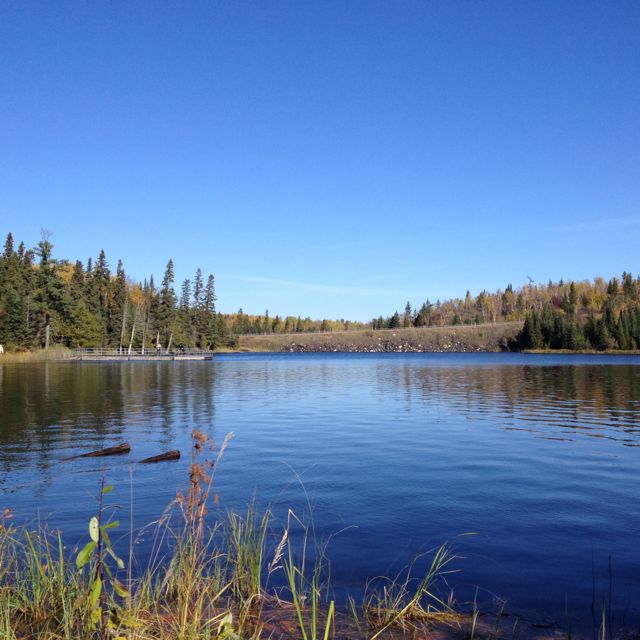
When we get there, he heads toward the dock, and I head into the woods. At some point, we meet for a shore lunch, but most of the day we enjoy our separate solitudes.
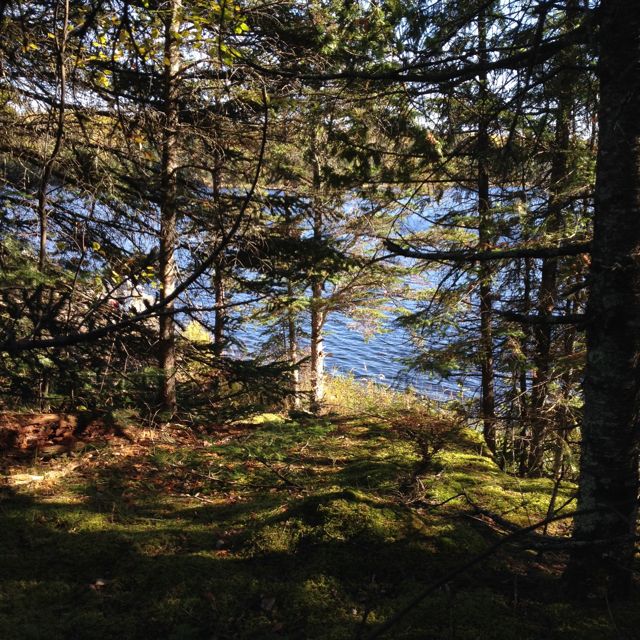 Today after wandering as far as the path would take me, I found myself drawn into the shadows.
Today after wandering as far as the path would take me, I found myself drawn into the shadows.
First it was a ladder of light climbing the moss on the side of a rock that pulled me away from the shore. 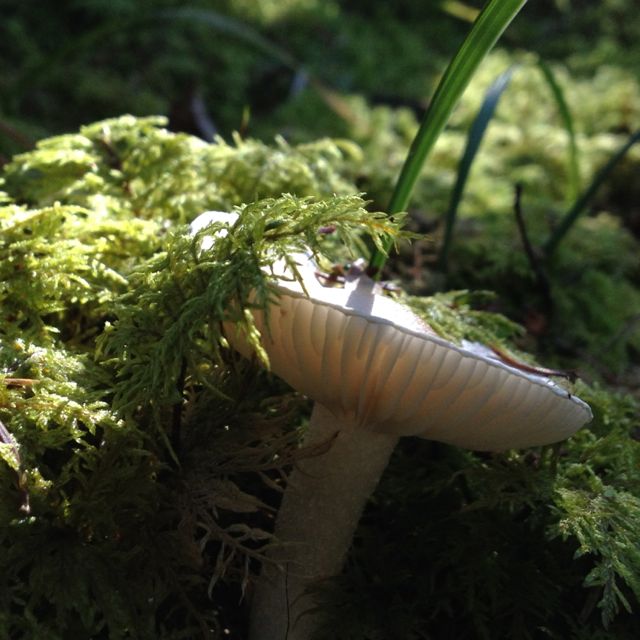
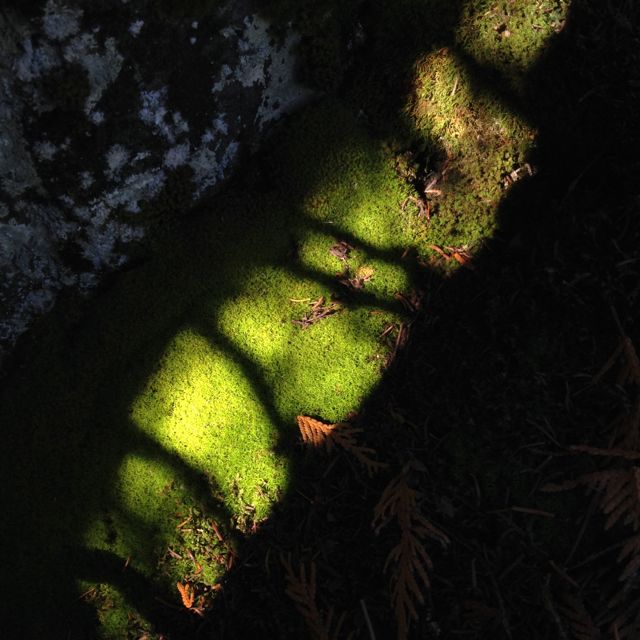 Then it was the lichen on a decaying branch. Like a tiny white forest perched precariously on a cliff.
Then it was the lichen on a decaying branch. Like a tiny white forest perched precariously on a cliff.
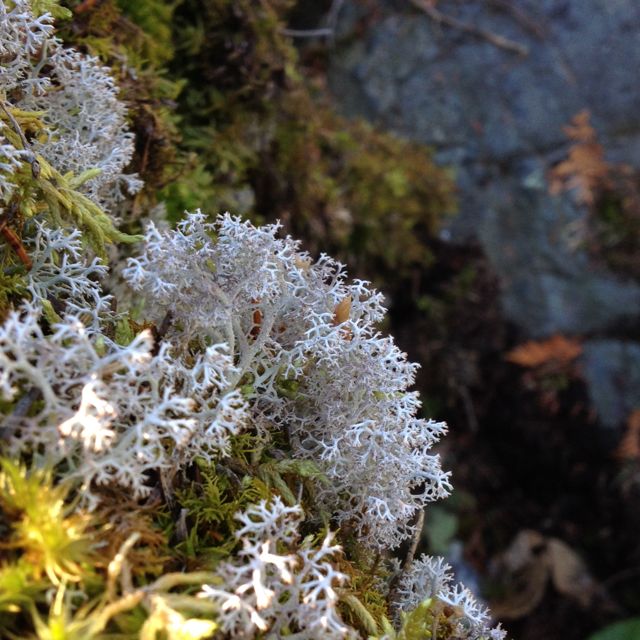 The closer I looked, the more I marveled at the intricate beauty growing in the shadows.
The closer I looked, the more I marveled at the intricate beauty growing in the shadows.
My curiosity drew me further into the woods.
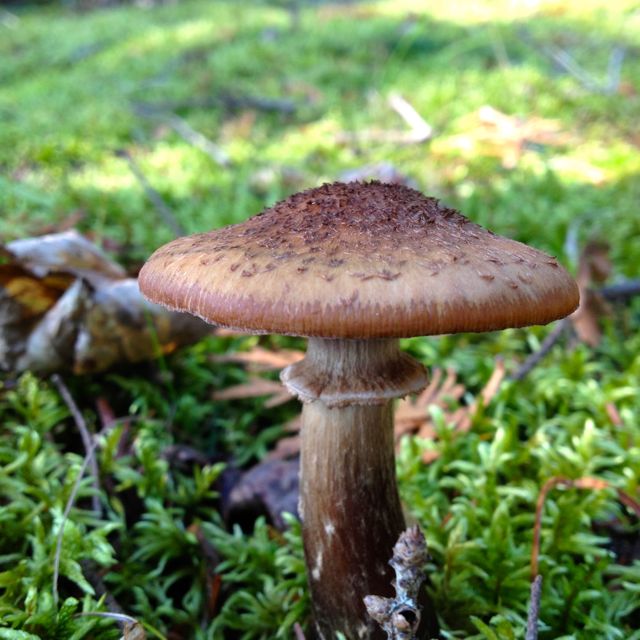 Crouching down in the moss, a whole world unfolded under my gaze.
Crouching down in the moss, a whole world unfolded under my gaze.
There were mushrooms that must certainly house mythical creatures at dusk when humans have gone home.
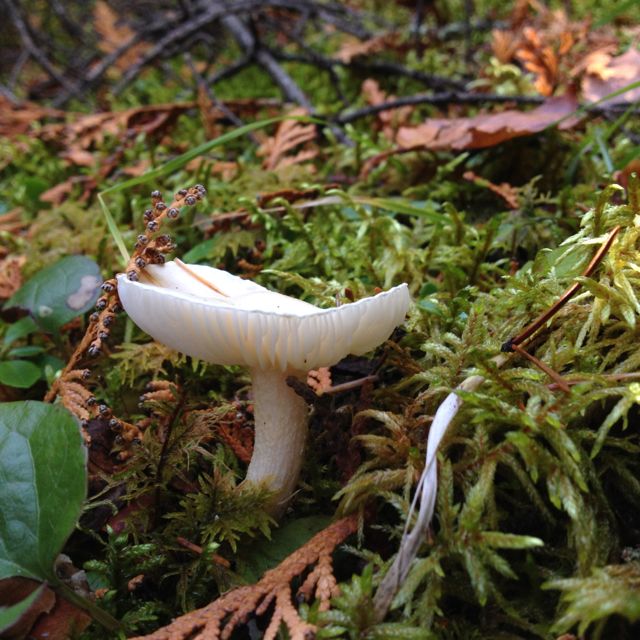 There were mosses in a thousand shades of green.
There were mosses in a thousand shades of green.
Each a tiny tree, dwarfed in the shadows of the giant trees all around it.
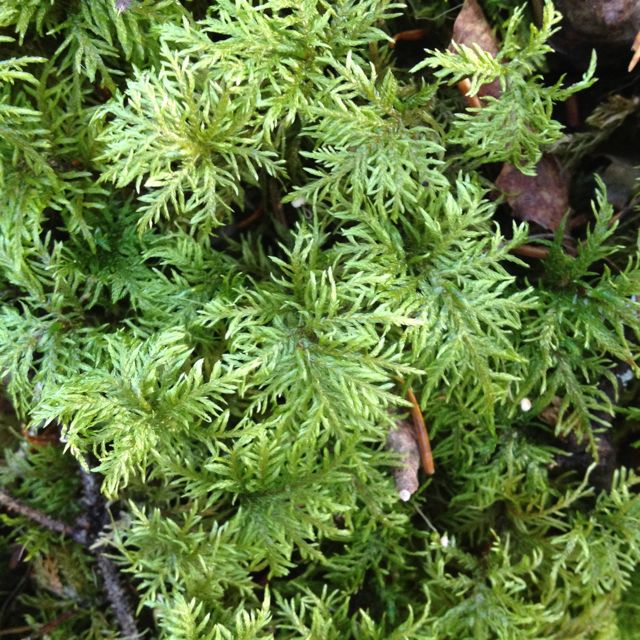 My knees were soon green and moist with reverence.
My knees were soon green and moist with reverence.
There was no end to the beauty, no end to the shadows.
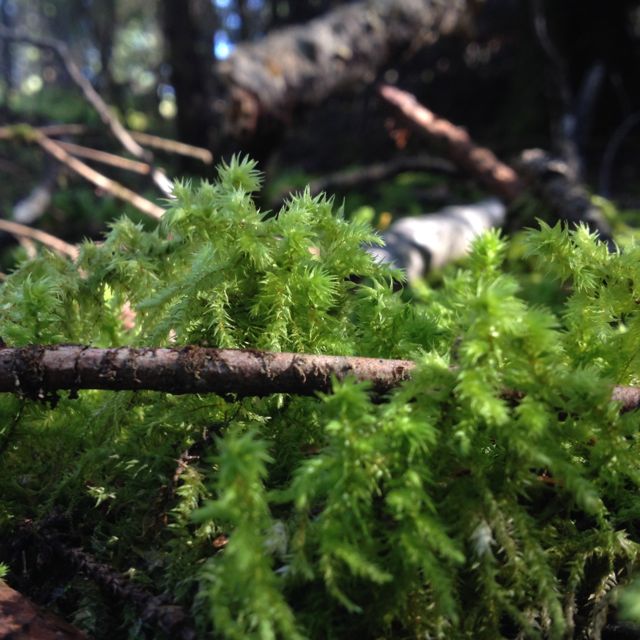 And as I marveled, I knew that I had opened an doorway into a universal truth.
And as I marveled, I knew that I had opened an doorway into a universal truth.
I knew that it wasn’t only in the woods that wonder waits in the shadows.
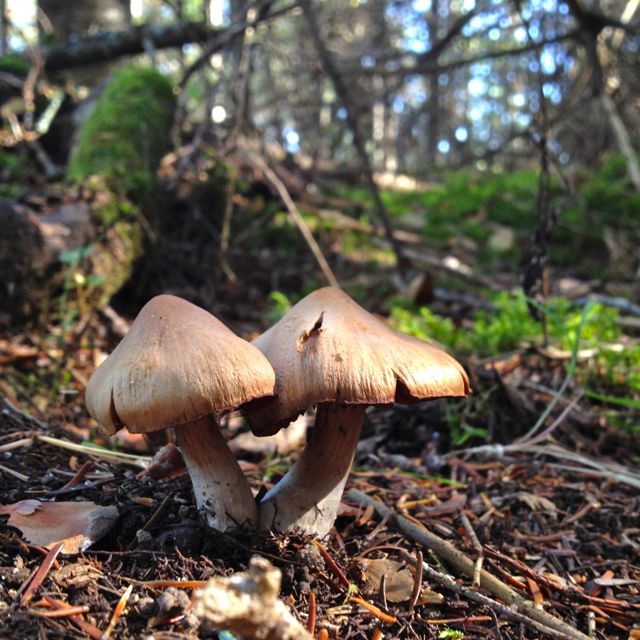 Once again, the woods were teaching me, tapping me on the shoulder and saying “Pay attention. This is important.
Once again, the woods were teaching me, tapping me on the shoulder and saying “Pay attention. This is important.
“There is beauty in the shadows. Things grow there that you don’t expect.”
 In the darkest of days, the unexpected shows up and offers grace.
In the darkest of days, the unexpected shows up and offers grace.
Like mushrooms and lichens and moss, there is wonder and beauty and wholehearted life that is available to us when we open ourselves to growth in the midst of shadows.
p.s. If you want to learn more about the gifts we receive in the darkness, that will be the theme of one of the lessons in The Spiral Path: A Woman’s Journey to Herself.
by Heather Plett | Sep 24, 2014 | circle, Community, Uncategorized
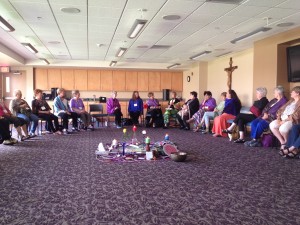 Something happens when women come into circle.
Something happens when women come into circle.
Tears flow.
It’s inevitable. When women feel held in a way they haven’t felt for a long, long time, their release valves open and the emotions they’d held tightly under their control begin to seep out through their eyes.
Something else happens after the tears begin to flow.
Women apologize.
Conditioned for most of their lives to distrust the tears and to see them as a sign of weakness, they worry that the tears won’t be welcome, that they’re inappropriate, that they communicate something they dare not communicate, or that the opening of that valve isn’t something they can undo and the tears will never stop. I see it every time I host a soul-opening class or retreat. Our tears trigger our shame and fear.
Women’s tears are a dangerous thing. They’re dangerous to the men (and women) who don’t know how to access their own emotions and who therefore think they’re being manipulated by others’ emotions. They’re dangerous to those who realize that women in touch with their emotions are harder to control. They’re dangerous to workplaces, schools, and churches that are built on structure, control, logic and order. They’re dangerous to those who release them because we don’t know where they will lead us or what they will shift in our lives.
Tears are dangerous because they open us up to emotions uncontrolled, secrets untold, stories unlived, and longings untapped.
But in that circle of women, if it is well hosted, tears are always welcome. Because we know – in our bones we know – that tears release us, they free us, they strengthen us, and they give us power. In last week’s circle (at Gather the Women‘s annual gathering), in fact, when we were invited to share an item that represented power in our lives, one women brought out a kleenex. “Because my tears give me power,” she said. Indeed.
So after we apologize out of our conditioning to do so, we loosen and relax into the tears and whatever else may come with them.
When women gather, some of the stories that bring tears are the stories about how our collective sisterhood, around the world and throughout the generations past, have been silenced, raped, murdered, and burned at the stake. For speaking out, for learning to drive, for challenging the patriarchy, for daring to follow their own spiritual paths, for being in the path of conflict, or simply for being women.
Last week those stories kept coming up in the opening circle and then in subsequent smaller circles. “We have generations of wounds,” some women said, “and we are afraid to cry about it in case we won’t know how to stop. We are afraid to cry because our tears have brought on the violence and sometimes even death.”
“We are watching our sisters die,” said others. “We are helpless in the face of those who are mutilating the genitals of our sisters in Ethiopia. We can do so little about the murdered and missing Indigenous women in Canada. We feel lost when we hear about young girls being sold into sexual slavery in India. We can do nothing about the young girls taken from their school by rebels in Nigeria.”
“We feel lost and helpless, but the only thing we know how to do is stuff in our emotions and carry on. We carry on because we are afraid to cry, afraid to care too much, afraid to truly allow ourselves to feel these deep wounds, afraid that we’ll be made fun of by those in control.”
At the end of a long day of hearing these stories, I felt weary and a little lost. I did what I almost always do – I carried my sadness into the woods. I walked up into the hills near the retreat centre, my shoulders weighted down with unresolved stories and unwept tears.
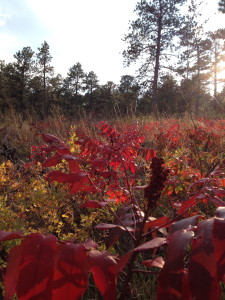 Up in the hills, I noticed an interesting thing. The hills were covered with low shrubs that had turned a brilliant shade of red (that I later learned were sumac) and had grown equally red seed clusters.
Up in the hills, I noticed an interesting thing. The hills were covered with low shrubs that had turned a brilliant shade of red (that I later learned were sumac) and had grown equally red seed clusters.
I stood on the path at the foot of a hill covered in red, and suddenly I didn’t see leaves anymore. Suddenly I saw a river of blood flowing down the hill.
It was the blood of centuries of women murdered and raped simply because they were women. It was the blood of the murdered and missing Indigenous women in my own country, the blood of the young women I met in Ethiopia who were beautiful and full of life when I met them and dead a few months later because they’d all been subjected to female genital mutilation with the same dirty knife, the blood of the women who’d been burned because their love of ritual and feminine spirituality was too dangerous and they were branded as witches, and the blood of so many other women all over the world who’ve suffered similar fates.
It was also my own blood, shed when a rapist climbed in my bedroom window and took my virginity away.
And it was the blood of Mother Earth, wounded by our corporate greed, destruction and insatiable hunger for her resources.
I stood there, at the foot of that river, and was suddenly overcome with emotion. I sat down at the base of a tree, surrounded by red, and I wept. I wept the unshed tears of my own stories. I wept for the women whose tears had dried up and who could cry no more. I wept for the way we’ve bottled up our tears, for the way we’ve let fear and shame keep us silent, and for the way we’ve been conditioned to accept our powerlessness in the face of so much brutality.
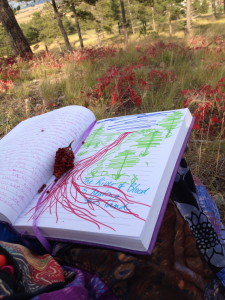 When the weeping subsided, I opened my journal and began to draw the river of blood. As I sketched, the words came to me… “The river of blood will heal this land.”
When the weeping subsided, I opened my journal and began to draw the river of blood. As I sketched, the words came to me… “The river of blood will heal this land.”
It didn’t make sense. How could the blood of our own woundedness heal anything? How can the victim be the healer?
I didn’t want to write it down, because I didn’t quite know what it meant and I resisted it. Perhaps I resisted because I was more inclined to look for blame and an external resolution than an internal path to healing.
But write it down I did. And suddenly the river was no longer the blood of pain and woundedness – it was the blood of menstruating women. The blood of birth and renewal. The blood of women’s power to co-create and regenerate. The blood of the new life that comes after the healing tears.
I leaned back on the tree and looked up at the sky. A large white cloud was above me and at the centre of that cloud was the cutout of a perfect blue heart. Love flowing down on me.
Across that heart flew a bird. A mourning dove – the symbol of forgiveness.
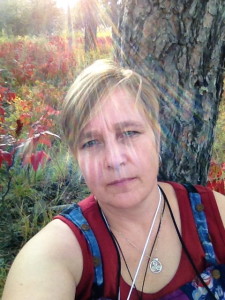 Wow. Forgiveness. That’s a tall order. Could I find it in myself and invite it in others?
Wow. Forgiveness. That’s a tall order. Could I find it in myself and invite it in others?
I stood up and continued walking. Further along the path was a ravine – a dried up riverbed coming from the top of the hill. At the bottom of that ravine were broken sticks and pine cones. Just like the red leaves had become blood, those sticks and pine cones became the bones of generations of women who have been killed – some of whom have been and continue to be dragged from the river in my own home town in recent weeks. (Including Tina Fontaine, a 15 year old girl found in a plastic bag in the Red River, who had been exploited and murdered.)
I climbed down into the river, determined to carry some of those bones with me as reminders. As I began to climb out, dead shrubs reached out like hands pulling at my skirt, determined to keep me there along with the bones of my sisters. I knew it was partly my own story – the rape I suffered at the hands of an Indigenous man – trying to keep me trapped, trying to keep me in a place of deadness. But I also knew that I’d been through a long journey of forgiveness and had no more reason to stay at the bottom of that river.
After I left the hills and went back down to rejoin my sisters, I wondered what to do with my story. Should I share it with the other women or should I keep it to myself for my own meaning-making? I shared it with a few women over dinner, and they encouraged me to share it more broadly, but I still wasn’t convinced.
Part of me believed that I was meant to invite other women into the hills for their own weeping and path to healing, but I just wasn’t sure. That night I had a dream that I did just that, and it was a disaster. People kept interrupting us on their way to a cafeteria that had appeared on the hill. And none of the women felt free to release their emotions in such a busy place. There was no freedom, no healing, just busy people leading busy lives.
The next morning before breakfast, I went back up into hills to pray and ask for guidance about what I should do next.
When I got to the base of the river of blood, I felt compelled to walk up through the river to find the source. I climbed to what I thought was the top, and there was a large pile of trees that had been cut down. “That makes sense,” I thought. “The blood is flowing from what we have cut from the earth and cut from ourselves.”
But there was more hill ahead of me. I hadn’t reached the source. I kept climbing. This time, at the real summit, there was something much different. A circle of benches. A place where people come to heal. A place where people come to be in community and to speak from their most authentic stories. A place where people learn to forgive.
Ahhh… this is the healing circle that is pouring healing blood down on the hills. The womb of the mother out of which new life is birthed.
As I stood looking at the circle and taking in this new message, something happened that shook me to my bones and made me weep again. Very close and very loud – a single gunshot.
Suddenly I was terrified. Was I safe? Was there a hunter in these woods who would mistake me for a deer? Would my own blood be shed on this hill? Or was the hunter after a cougar I’d been told could be in these hills and I was at risk of both cougar attack and misplaced gunfire?
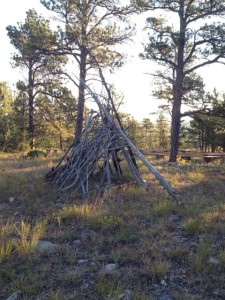 Near the circle was a teepee someone had built out of fallen logs. Full of emotion and fear, I crawled into the centre of the teepee. There I suddenly felt safe, held in the womb of the Great Mother. Surrounded by love and not fear.
Near the circle was a teepee someone had built out of fallen logs. Full of emotion and fear, I crawled into the centre of the teepee. There I suddenly felt safe, held in the womb of the Great Mother. Surrounded by love and not fear.
Later that day, I knew what I needed to do. I needed to invite other women to the hill.
So I shared my story and said “for any of you who feel the need to weep with me, for all of women’s pain and for your own, join me at 4:00 and we will walk up the hill.”
Several said they’d join me. Others said they wouldn’t or couldn’t but that they would hold us in their prayers while we made the journey.
I had no idea what we’d do when we got up the hill, but I had a sense that we needed some kind of lament ritual, and that the journey up the hill needed to be treated like a pilgrimage or labyrinth walk – releasing, receiving, and returning. Some of the wise women who couldn’t make the hike up the hill gave me little words of wisdom. “Be sure to give them a way of weeping unhindered and safe – a shawl to place over their heads that shields them from everyone else.” “Take something with you to cleanse the space and to bring people back to a place of groundedness afterward, like sage perhaps.”
Gradually, trusting that I was given the wisdom I needed to host this pilgrimage, I leaned into it. When the women gathered, I invited Tubears, a wise elder from Reno, to offer a prayer for all of us. We stood holding hands as she prayed, and then I invited each woman to express which stories were on their hearts – their own or other women’s. “Start a sentence with ‘I carry with me the stories of…’ and share one little piece of what you’re carrying up the hill.”
And then, in silence, we walked up the hill. At the foot of the river of blood, I invited them to wander in silence for awhile and to simply be open to what the hill wanted to say to them. After 10 minutes, I called them back together and said, “Now we are going to move into a lament. We are going to release some of the pent up emotions we’ve denied ourselves, some of the tears we’ve been afraid to shed, some of the pain of witnessing our sisters’ deaths and rapes. It may feel funny at first and you may need to fake it for awhile, but simply allow it to feel weird and carry on. This is counter-cultural. It’s not going to feel normal. Simply allow whatever comes up for you to be okay and safe in this place with your sisters. Sit where you feel safe and held, close enough to us to know that you are in community, but far enough away that you have some solitude. Cover your head with your shawl if you wish, and weep. Once the time is up, I will come to each of you and place my hand on your head. That will be your invitation to emerge out of your weeping and return to the circle.”
Women spread out over the hill and found their places. We began to weep and wail, some loudly, some more at the level at a hum. In some moments it felt fake and put-on, but in other moments deep convulsions of remembered pain welled up and we were weeping for real. I wept for some of my clients who are healing from deep wounds and historic pain. I wept for a beloved sister-in-law who’s been on a long healing journey. I wept for my daughters and nieces who still have so much to navigate as they come into adulthood. And I wept for the women I’d met in Ethiopia and India and the women from my country being found in the river.
When it felt like the right time, I rose and walked from woman to woman, gently placing my hand on their heads and holding it there like a blessing and invitation, reminding them that they were safe and held in love as they came out of their lament.
We gathered in circle once again, did some deep breathing exercises to release some of the heaviness, and then I invited my friend and co-guardian Hali to offer a cleansing smudge for each woman. Then we passed a talking piece – a stone I’d found on the hill that at first felt like a blade in my hand but then transformed into the shape of a woman as I held it. I invited them to each speak of one thing they were taking with them from this experience.
“When you exit a labyrinth, after you have received what was in the centre for you, you walk slowly in your return to the world, integrating this new wisdom or calling into your hearts and your bodies. I invite you to walk slowly in silence down the hill. Take the time you need. Do the self care that will help you be gentle with yourself. Don’t rush into telling other people about this experience until you are ready for it.”
Slowly and individually, we made our way down the hill. When we got there, I tried to enter into dinnertime conversation, but it just didn’t feel right. Instead, I disappeared from the table and went first to the quiet room where our circle of chairs were and then went to my room to have a hot bath.
I’m not sure what this will mean for the women who were with me. Many of them shared how meaningful it was and how it cracked their hearts open, but mostly I am expecting that they will process it in their own way in their own time. They are each on their own journeys, and if this at least helped them honour their wounds in a new way and seek healing for something unspoken, then they are on the right path. Some might be frightened of the wound and need therapists or other healing practices that help them process what’s been opened up.
I know, though, that this will change my work. I’ve received a new calling – or perhaps a deepening of a calling I knew I already had. A few years ago, I heard a woman from the stage say the words “The world needs people who know how to navigate in the dark” and I knew then that her words were meant for me. I’ve known for quite awhile that part of my work was to help people walk through the shadow, through the grief, and through the wound.
This isn’t easy work – because few people want to be invited into darkness – but it is essential work and I know I need to do it.
I shouldn’t have been surprised, then, when, in the very first coaching session I had after my return to work, a woman who ostensibly wanted to talk about how much she wanted to change her career, revealed only a short time into our conversation that her restlessness was more about unhealed wounds and a darkness she was afraid to enter into than it was about her career.
And then yesterday, as I was washing the dishes, a hit of inspiration arrived. I will be creating a new course that will be somewhat like Mandala Discovery (where you receive a prompt every day) but will invite women to journal and/or do art-making prompts as they take a figurative journey that resembles a labyrinth walk. It is tentatively called “A Spiral Path: A Woman’s Journey to Herself“.
I also expect that there will be upcoming retreats based on this theme. AND there has already been an invitation to help create a lament for women on a fairly large scale at an event next year. If you want to learn more about any of this as it unfolds, add your name to my email list (at the bottom of the page) and I’ll keep you informed.
Also, if you are interested in how an openhearted writing practice can help you through this journey, join me for a one day online Openhearted Writing Circle on Saturday, October 4th.
Blessings to you wherever you are in this journey.
by Heather Plett | Sep 12, 2014 | grief, mandala, Uncategorized
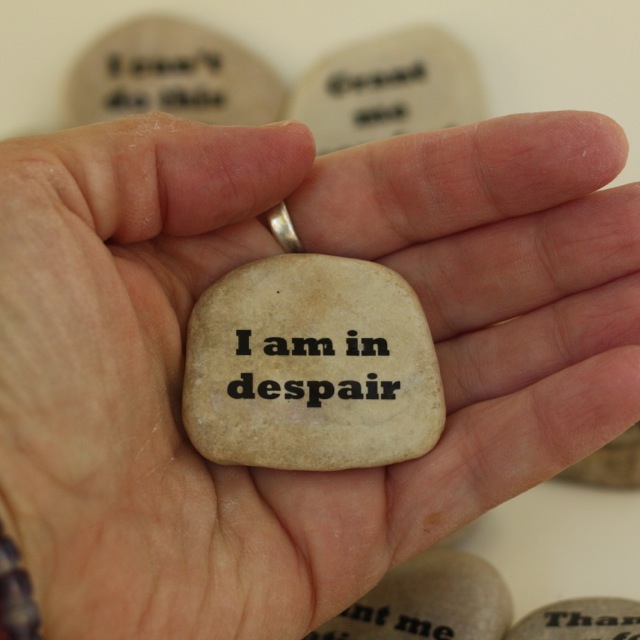 Hardly a week goes by that I don’t get an email with words like “How do you get through the rough spots in life?” Or “I feel lost. What should I do?” Or “What do you do when you are in despair?”
Hardly a week goes by that I don’t get an email with words like “How do you get through the rough spots in life?” Or “I feel lost. What should I do?” Or “What do you do when you are in despair?”
Some people are looking for coaching, some are simply asking for advice, and some have read a blog post about my own personal rough spots and think that I might have some wisdom to share. “You seem to know how to walk through the rough spots with strength and resilience,” the emails often say. “I want to know how to do that.”
Depending on the situation and the depth of the despair, I might take them on as clients, I might offer them a story or some encouragement, or I might recommend they see someone else who’s better qualified for the particular challenge the person is going through.
Hardly ever do I feel qualified to give them advice. Most of the time when I get these emails, my first reaction is “But… I’m not an expert in navigating despair. All I do is muddle through. And sometimes I feel so completely mired in it, I feel like I’m drowning. How could I possibly be of service to others?”
Last week was one of those times when I doubted my own ability to offer anything of value. Not that I was in a particular place of despair myself, but rather that I saw so much of it in the world around me that I felt completely inadequate.
Three of those emails came within the span of three days. I put off answering them, weighing my words and wanting to offer what was of the most value. Wanting, most of all, to leave these people feeling like they were not alone and that there is some tiny point of light in their darkness.
Before I had a chance to respond to any of them, I found out that an old friend (who’d been my roommate when I was 19 and entering the minefield of adulthood and independent living) was killed in a tragic car accident and had left behind three daughters just a little older than my daughters. I haven’t kept in touch with her much in recent years, so it wasn’t so much that I felt a huge hole in my own life, but I kept thinking about the people – her daughters, husband, parents, siblings, etc. – who do have huge holes in their lives. How can it be fair that three young daughters now have to navigate adulthood, parenthood, and all of the other things that are coming in their future, without their mother? Why did she have to die only a week after celebrating her daughter’s marriage?
And then I extended those thoughts and that grief to my own story and all of it felt too overwhelming. What if I lose my brother? What if my niece and nephew lose their dad just as they’re moving into adulthood? What if my sister-in-law has to learn to walk in the world as a widow?
I came home from the memorial service feeling completely raw and spent. My well was empty. I had nothing to offer, no resources to draw on. I snapped at my kids when they argued and was abrupt with my husband when he asked for something. I didn’t want to be the grown-up in any situation, much less the coach or teacher that people turned to while trying to navigate the darkness.
After a good night’s sleep, I woke up feeling a little more able to be an adult. After driving the girls to school (without any snapping), I sat down to scan Facebook, and someone had shared a TED talk by Andrew Solomon about how the worst moments in our lives make us who we are. The timing couldn’t be more perfect. Solomon talks about how we forge meaning out of the difficulty in our life, and that meaning shapes our identity.
Ah yes. We forge meaning. That’s one of the most important things that I know about the times of despair. It may be almost impossible to see it when you are in the middle of the darkness, but when you emerge, you begin to make something meaningful out of all the broken pieces of your shattered life. And as your strength grows, you realize that you are who you are partly because you survived the darkness.
After having a stillborn son, for example, I knew that that experience had been a spiritual turning point for me. Nothing before in my life had left me more awakened and hungry for a deeper faith and spirituality. And nothing else had ever made it more clear to me that I needed to follow the path of my own calling rather than trying to conform to what was expected of me. My priorities became suddenly crystal clear. My life is vastly different than it might have been if I hadn’t landed in the hospital for the final three weeks of my pregnancy and then left the hospital with empty arms. I am wiser, stronger, more clear about who I am, and more spiritually awake.
Once you’ve picked yourself up and figured out how to make something meaningful out of the mess, a few things happen:
- You realize you are stronger than you thought you were. You look back at the darkness and realize that it didn’t conquer you. You have reserves of courage and strength you didn’t know you had.
- You begin to tell different stories about yourself. You are no longer a victim. You are no longer lost. You are a survivor.
- The next time you are faced with a challenge, you face it with a little more courage than you did the last one, because you know you are capable of surviving. You know the darkness can’t conquer you. You might still get knocked off your feet, but you have a little more faith that you’ll be able to get back up again.
In the book David & Goliath, Malcolm Gladwell shares a story of the air raids on London during the Second World War. Anticipating mass hysteria and intense anxiety, the government at the time built psychiatric hospitals in preparation. But the hospitals didn’t fill up. People were much less anxious than they’d expected. Why? Because they survived. Because the first time the bombs fell, they walked away from it and realized that they were still alive and could go on. Each time the bombs fell, they got a little stronger and more able to keep on going without being paralyzed by fear.
In Pathfinder and in many of my coaching sessions, I tell people to carry a basket of courage stories with them. “Write down the stories of times when you had courage,” I say, “and then when you need a reminder, go back into that basket, pull out the stories, and remember that you are a courageous person and you can survive the darkness.”
After watching the TED talk, I finally opened my email, determined to offer the best response I could to those who were reaching out, not because I was an expert, but because I was a survivor. I’ve been through the dark – many times. I know how to look for the points of light. I know how to take tentative steps even when my feet feel mired in clay.
As I began crafting my responses, I was reminded of one of my favourite quotes from George Bernard Shaw.
“I’m not a teacher: only a fellow traveler of whom you asked the way. I pointed ahead – ahead of myself as well as you.”
I don’t claim any expertise in despair navigation. I am not a psychologist or therapist. I am only a fellow traveler who has been through the darkness many times. Surviving rape, the death of my son, the suicide attempts of my husband, the death of my mom and dad, and many other challenges, didn’t make me an expert, but they taught me to survive and to forge meaning. And that makes me not an expert, but “a fellow traveler of whom you asked the way.”
If you are in despair, I offer you these small pieces of wisdom on navigating in the dark:
1. Believe that it will one day be better than this. Nobody stays in the darkness forever. There is an ebb and flow to every life. We walk through it all and none of it lasts forever. You may not see light today, but perhaps tomorrow, perhaps next week or next month, the light will poke through.
2. Make something. There’s something about the act of production that helps make the darkness a little lighter. Bake a cake, draw a picture, make a model airplane – it doesn’t really matter what you make but it does matter that you get your hands busy and create something. One tiny act of productivity and one simple thing made by your own hands can shift a spiral of negative stories going on in your head. When my husband was in despair in the psychiatric ward, the only time I saw light in his eyes was when he was making a model airplane in the art room.
3. Move your body. Get active. Run, dance, walk, swim – do something to get your muscles moving, your heart rate up, and your adrenalin flowing again. A little dopamine flowing in your brain can help you see the points of light in the darkness. Start with something simple – walk around the block.
4. Pray. Even if you don’t have a particular faith, prayer helps. Reach out to the God of your understanding, your Higher Power, even if the only word you say is “Help!” Look outside yourself for some source of hope. As Andrew W.K. says in this article, “‘Getting down on your knees’ is not about lowering your power or being a weakling, it’s about showing respect for the size and grandeur of what we call existence — it’s about being humble in the presence of the vastness of life, space, and sensation, and acknowledging our extremely limited understanding of what it all really means.” (If prayer is unfamiliar to you, or you need some prompts, Prayer Stones might help.)
5. Talk to someone. You’re not meant to survive this time of despair alone. We are social animals – we’re meant to live in community. There is no shame in asking for support. Start with a friend, family member, or someone you trust. Or reach out to your doctor, find a therapist, or look into grief coaching. If you need someone to help you find a place to start, you can contact me. I don’t have the answers for everything, but I know a lot of people working in helping professions – one of them might be the right person for you.
6. Get outside. Stand in the sunshine. Get fresh air. Lean on a tree. Nature heals. Breathe in the oxygen the trees offer as a gift, watch the seasons change, and remind yourself of the way the earth regenerates herself, moving from death to life and back again. Spring comes back every year. Life returns to the landscape that lies dormant under the snow.
One of the people who’d emailed me earlier had made a special request of me. It wasn’t advice or coaching she was looking for – she simply wanted me to pray and make a prayer mandala for her. And so I did, because – like it says above – prayer helps, and making something helps. I made it for her and I made it for myself and I made it for all of the other people around me who are currently in despair.
With my house full of stones these days, I decided to make a prayer mandala out of stones. I started at the centre, choosing a few Prayer Stones. 
The mandala grew, and at the outer edges I added Intention Stones that reflected the meaning that I have forged out of my own times of despair and that I wish for those still in it.


The act of making the mandala, even without any words coming out of my mouth, was my prayer, my offering up of those things that are outside of my control and outside of my understanding, and my way of catalyzing the overwhelm and feeling of inadequacy.

May you find your way through whatever challenge you find yourself in and will you know peace and grace. And may the meaning that you make of it all become the gift you offer the world.
Prayer Stones and Intention Stones are available in my Etsy Shop. And if you’re interested in being part of a coaching circle that will help you find your way, check out Pathfinder Circle, starting again on September 30th.
by Heather Plett | Apr 18, 2014 | Uncategorized
“Because we realised that the person who left us did not take the sun with them or leave darkness in their place. They simply left, and with every farewell comes a hidden hope. – Paul Coelho
Three years ago, on Easter weekend, we found out my mom had cancer. It was a sombre Easter meal we shared at my brother’s house that Sunday. Mom did her best to be upbeat, playing with the grandchildren, making sure everyone was well fed and giving us all as much love as she could. We all tried to do the same, to pretend that everything was going to be okay and that we didn’t risk losing the only parent we had left.
We didn’t do a very good job of lying to ourselves, though. Beneath all of the smiles and the laughter was a river of worry that none of us could deny.
Once you’ve met death and watched it take away a member of your family, you no longer have the luxury of hanging onto the lie that “everything is going to be alright”.
Something else happened that weekend. On the two hour drive home from my brother’s house, my marriage unraveled. We had a big fight (as quietly as possible so as not to alarm the children in the back seat) and I had to speak out loud the unhappiness that was growing in me like my mom’s cancer was growing in her. It was time for drastic measures. We had to either slice out the cancer in our marriage and subject it to months of chemo (in the form of therapy) or it would die.
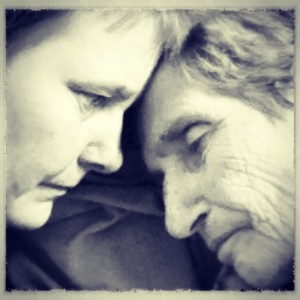 By now you probably know what happened to my Mom. She had surgery and months of chemo and the doctors thought they had been successful in arresting the cancer. But only three months after she’d gotten the “all-clear” (which happened a year after her diagnosis), they discovered that the cancer was still growing and was now beyond treatment. Three months later, with all of her children gathered around her, she left us to join Dad in eternity.
By now you probably know what happened to my Mom. She had surgery and months of chemo and the doctors thought they had been successful in arresting the cancer. But only three months after she’d gotten the “all-clear” (which happened a year after her diagnosis), they discovered that the cancer was still growing and was now beyond treatment. Three months later, with all of her children gathered around her, she left us to join Dad in eternity.
As for my marriage, a rather similar pattern took place. We went for months of counseling, worked on the baggage we were both carrying, learned to talk to each other with more honesty and less anger, and thought we had the cancer licked. We were happy again.
But then the cancer came back. I realized that the anger that had infected me was growing in deeper places than I’d at first admitted to myself. A deeper excavation was necessary. And so we went under the knife again, followed by more chemo.
Our marriage is still alive. Like doctors, we are using every procedure and medicine we can think of to keep it alive. We are trying – like the Japanese artists who mend broken pots with gold so that the break becomes part of the art and history of the piece and adds to its beauty – to mend our marriage with even stronger and more beautiful material than was there when the break happened.
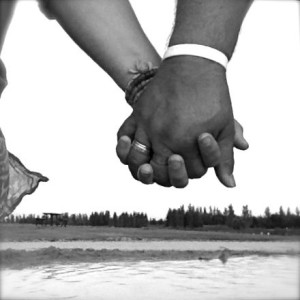 It seems fitting (and perhaps somewhat ironic) that this year, at Easter, I am feeling hopeful again. There is resurrection, there is transformation, there is hope. The gold is beginning to set deep into the cracks and there is beauty emerging out of our brokenness.
It seems fitting (and perhaps somewhat ironic) that this year, at Easter, I am feeling hopeful again. There is resurrection, there is transformation, there is hope. The gold is beginning to set deep into the cracks and there is beauty emerging out of our brokenness.
In Pathfinder, I wrote about the value of getting lost, of tearing up the map, and trusting that the path will unfold in front of us as it should. That’s a lesson that I have to learn again and again. I want so badly to control the outcome, to fix the cancer in my mom (and now my brother), to find a simple solution for our marriage, or to, at the very least, feel like I’m holding a map in my hand that will show me the topography that’s up ahead. But I don’t get that. I never get that.
I have to let it go and lean further into trust.
In order for real transformation to happen (as we learn in Theory U, which is also shared in Pathfinder), we have to let go of the outcome and our desire to control it, let go of our preconceived notions, let go of the lens through which we view the world, and learn to sense into that which wants to emerge. Along the journey of letting go, we open our minds, open our hearts, and open our wills. Only once we’ve reached the bottom of the U, when what needed to die has been released, can the new thing emerge and begin to blossom.
My friend Laurie Foley was recently told that her cancer is in remission. As she explores what this means and what she is meant to learn from her long months of struggle, she is re-framing remission as re-mission. She’s wondering how this period of her life – the journey through the valley of the shadow of cancer – has changed her life’s mission and what God is asking of her now.
I wonder the same thing. If the cancer in my marriage is in remission (as I hope it is), then what is our re-mission as a couple? What is emerging for us that we couldn’t see before when we were blinded by the struggle? It is our hope that the three year dive into the bottom of the U has allowed something new and beautiful to grow out of the brokenness.
I share this story with you not for any sympathy or advice. I share it simply that you will know that you are not alone. If your marriage feels broken, if your community is falling apart, if your business is failing, take heart.
There is beauty that grows out of the brokenness. There is hope even in loss.
Yes it’s true that sometimes there is no stopping the cancer and someone or something dies. Your marriage may end, your best friend may die, you may lose your job or your home. We can’t change that, no matter how hard we try.
But that doesn’t mean it’s the end. It doesn’t mean you’re finished. It means that you’re finding yourself at the bottom of the U and someday, when you have let go and opened yourself up to some new possibility, the light will appear again and a new seed, planted into the compost of what has died, will begin to sprout.
In the Easter story, Christ had to give up his life on the cross before he was ready for his own re-mission. Only when his surrender was complete and death had taken him could he rise again and live out his calling to be fully God.
That story always makes me think of butterfly metamorphosis. A caterpillar must give up its caterpillar-self in the gooey mess of the chrysalis before it can emerge as a butterfly. In the same way, we have to release that which no longer serves us – let it fall broken in a heap at our feet – before we can emerge into the beauty that calls us forward.
It is my hope this Easter (whether or not the Easter story is part of your faith tradition) that you will find beauty in the brokenness, that you will recognize the value of getting lost, and that you will learn to see the light that peeks into your shadows.
And if you find yourself lost, somewhere on the journey through the U, consider joining us in the Pathfinder Circle. Your brokenness, your questions, your growth, your curiosity, and your grief will be held in a circle of grace.
by Heather Plett | Aug 15, 2013 | art, Beauty, circle, Community, grace, Spirituality
I am home after nearly two weeks of journeying across the prairies. It was amazing. I am replenished, encouraged, and feeling full of the goodness of this earth and the people on it.
I am still on a bit of a high and not entirely sure that I have the right words to articulate what this journey meant for me, but I’m going to try anyway, before it slips too far into the past and is lost in a sea of other stories that want to be told.
Part 1: Journey to myself
“In solitude, at last, we’re able to let God define us the way we are always supposed to be defined—by relationship: the I-thou relationship, in relation to a Presence that demands nothing of us but presence itself. Not performance but presence.” – Richard Rohr
Though I could have easily gotten to Calgary with one long day of driving (and have done it many times), I chose to make the trip in two days so that I could savour the trip and enjoy a night of camping by myself. As Richard Rohr writes in Falling Upward, the older I get and the more I learn to love and understand myself, the more I enjoy my own company.
From the moment I left the city limits, I knew there was going to be something special about this journey. It was a stunningly beautiful day, with the kind of fluffy, storybook clouds artists and photographers pine for. It was also the perfect season, when there are still rich summer greens mixed with subtle autumn golds, browns and reds. The canola and flax are in full bloom, the wheat and barley fields are readying themselves for harvest, the round bales are beginning to be laid out across golden hay fields, and the calves born in early summer are strong, virile, and rambunctious.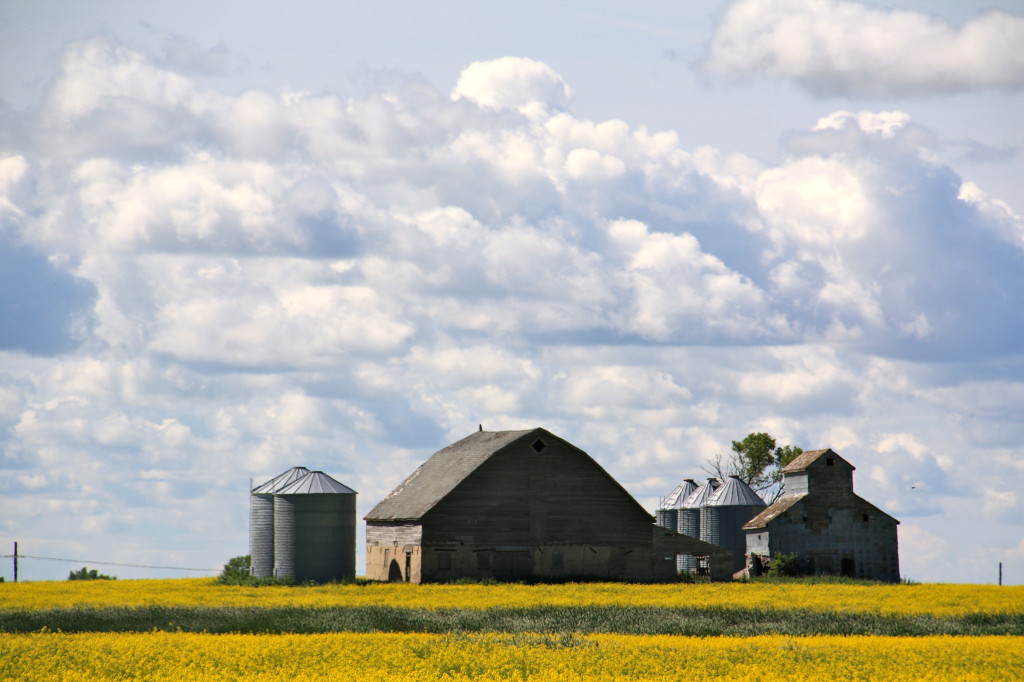
Everywhere I looked, the prairies seemed to be laying out their finery for me. I couldn’t resist stopping for photos of bright red barns set against bold blue skies, fields where flax flowers flowed like the waves on a peaceful sea, and ditches where butterflies and dragonflies danced from wildflower to wildflower.
When I pulled into Regina, I stopped for a bottle of wine and a cheap plastic wine glass (to enhance the picnic I’d brought from home) and headed to my campsite by a lake. The first thing I spotted at the campsite was a shiny loonie (dollar) on the ground – like someone had left it as a good luck charm.
Pushing through a broad strip of clover that stood higher than my head and smelled of heaven, I came to the lake. There in front of me, for no reason I could ascertain, was a picnic table half submerged in water. I waded out to the table and sat on it for awhile, snapping photos of fishermen, seagulls and rocks. The sun was about two hours from sunset, as far as I could tell, but I didn’t want to miss a moment of its setting. So I brought my picnic lunch and journal to the table and spent the next two hours on my little wooden island in the lake, hidden from view from most people by the huge stand of clover along the shore.
Those two hours were magical. My senses were heightened after a day full of prairie beauty, and every angle, every bit of light, every shadow, every rock, every bird, every line, and every reflection was drenched in beauty. For two hours I sat in awe, watching the light change on the lake and the clouds glow in the sky. God’s presence was palpable. It was one of those thin places that the Celts talk about, where heaven and earth collide.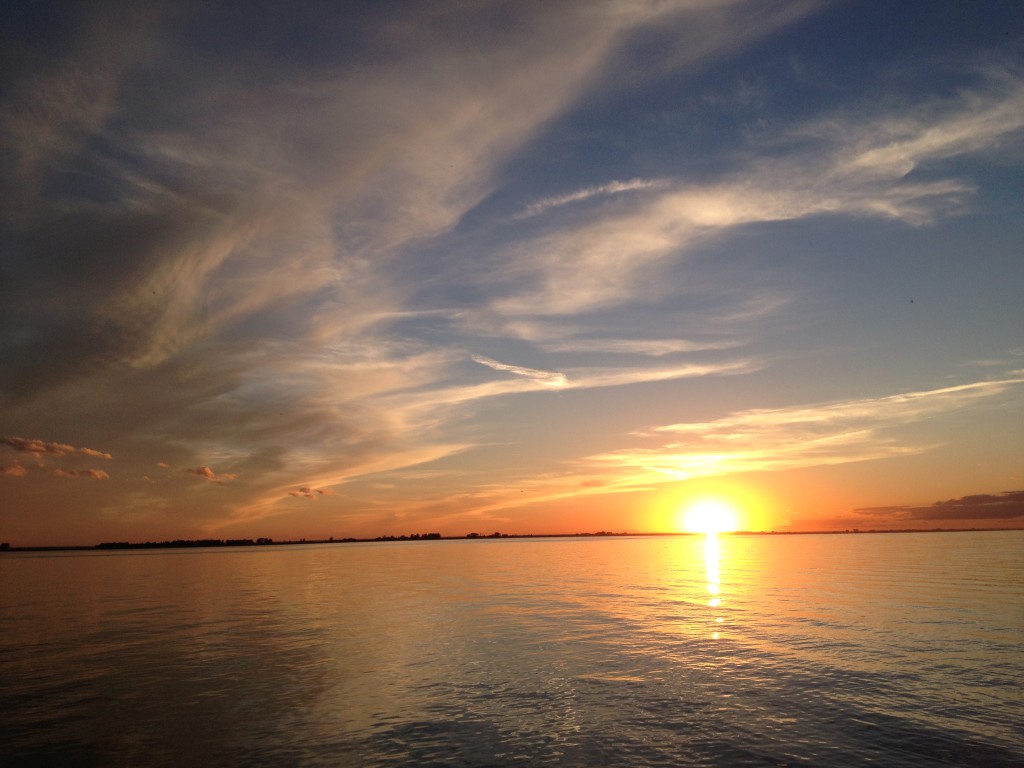
After the sun set, and night began to drift across the lake, I lit a fire at my campsite and had another magical hour of capturing light of a different kind – orange, glowing, flickering, pushing against the darkness. From the largeness of the sunset sky to the smallness of my cast iron fire pit – I was mesmerized by light.
The next day was much like the one before, with equally piercing blue skies and impossibly white clouds. I wandered on the beach, took pictures of more birds, feathers, and rocks, and then started the drive to Calgary. At one point, a storm rolled in, and the clouds changed to dark and dramatic. After two days of beauty, I wasn’t surprised to see a rainbow show up.
By the end of the day, I felt like I had just been courted by a devoted lover who was doing everything s/he could to make me feel special. In the words of Richard Rohr in the quote above, I was very much in “the I-thou relationship, in relation to a Presence that demands nothing of us but presence itself.” I found God on the prairies and God laid out the finest that the prairies had to offer to make sure I felt loved.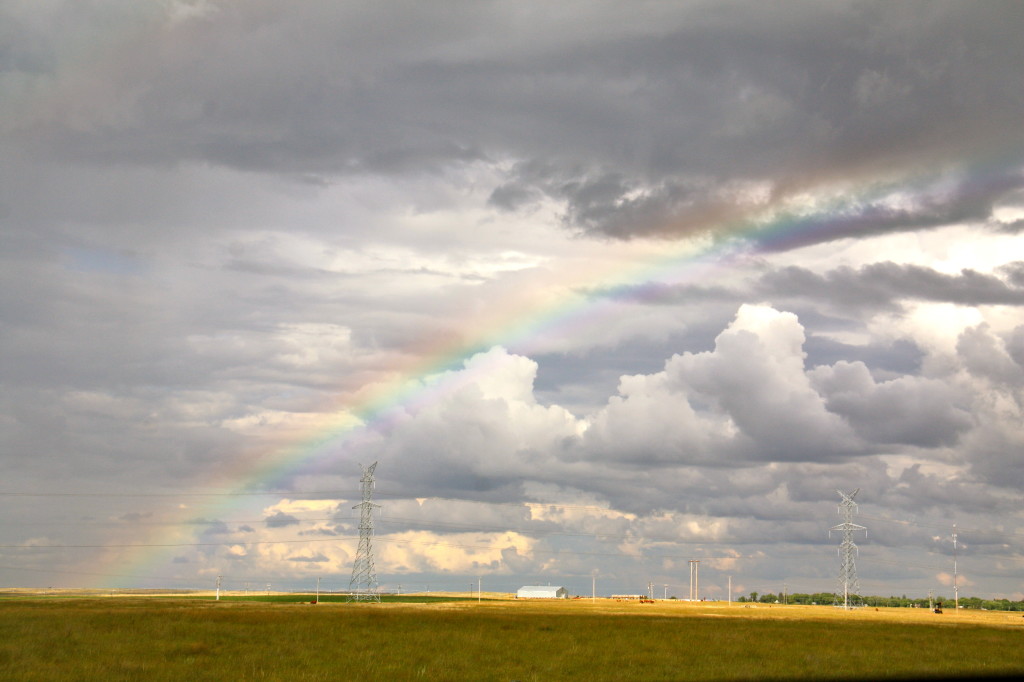
For more photos of my prairie journey, here’s a little video I put together.
Part 2: Journey to my family
“Always remember, there was nothing worth sharing
Like the love that let us share our name.” – The Avett Brothers
The purpose for my trip to Calgary was to visit my oldest brother, Brad, who’d been diagnosed with cancer a few weeks earlier and had had a three foot section of his colon removed the week before. When I’d heard about his cancer, I’d felt an intense need to spend time with him, and so I took advantage of the opportunity. It’s been a hard year for our family, after losing Mom to cancer in November, so the bond between us feels especially important.
If you met my big brother, you might marvel at the many ways that our world views are different, and – on the surface level – you might even question how we find common ground. His politics lean further right than mine do, he’d rather spend the afternoon in a hockey rink while I’d choose an art studio, and he doesn’t see the point in much of the self-discovery or community-building reading and writing I do while I’d be bored to tears with the kind of detail-oriented computer coding he does. (It almost seems like a cliche that he has a degree in math and I have a degree in literature.)
And yet… if you looked at only those things, you’d be missing a lot. For one thing, there’s something about 47 years of shared history, stories, jokes, faith, questions, and grief that creates a common language that few people in the world can understand. There is great safety and comfort in that common language, especially after you’ve lost a few of the only people on earth who know it. When you are in a place where you can speak that language and ask those questions without fear of judgement, it is worth more than gold.
And there’s another thing… unleash us in the mountains, on the prairies, or by the seashore with our cameras, and both of us can wander happily for hours. (Or – in the case this week – lament the fact that we can’t wander for hours due to a recently broken foot and major surgery.) And then we can sit together on the couch for another couple of hours going through the pictures to find the few in which we’ve captured the light just right.
In those things, there is plenty of common ground to make a trip across two provinces after a cancer scare an indescribably worthwhile thing to do.
I didn’t know how this visit would go, and frankly, I was a little worried to see what cancer was doing to my normally energetic and adventurous brother. On top of that, my sister-in-law (whom I also love dearly, and would easily cross two provinces for as well), has been dealing with some pretty heavy things this year, and my teenage niece has had an interesting recent time of learning more about her identity as well.
I expected their home to be full of turmoil and sadness… and yet… it wasn’t. There was a surprising amount of peace and grace in their home, not to mention a whole lot of love. My brother has a remarkable capacity for accepting life as it is and enjoying every moment that he can, and my sister-in-love has a remarkable capacity for making meaning of what is and articulating it in a way that shines new light into it. Plus they both have a deep faith that sustains them and gives them hope.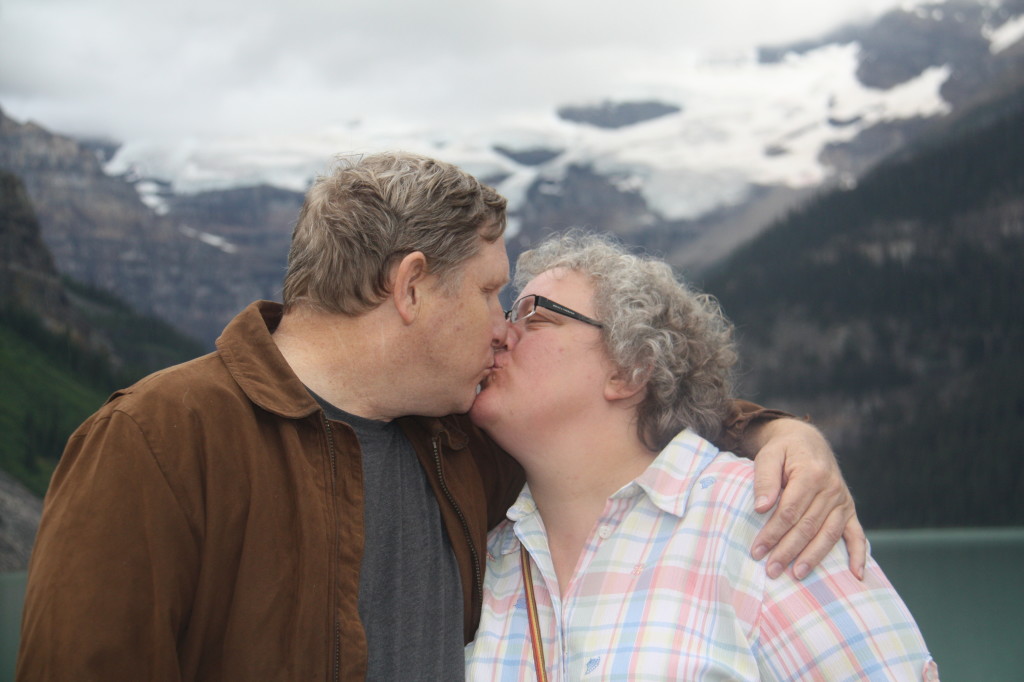
One of the most poignant moments of the visit was when I stood next to my brother in church (yes, he’s stubborn enough to go to church two days after being released from the hospital) and sang “Come Thou Fount”, a song that has a rich history in our family and was sung at both of our parents’ funerals. “Here I raise mine Ebenezer; hither by thy help I’m come; and I hope, by thy good pleasure, safely to arrive at home.” The Bible verse that those lines are inspired by was made into a wall hanging for Mom and Dad’s 25th anniversary, and hung in their home for twenty-three years after that until Dad died and the farm was sold.
Another poignant moment was standing at the shores of Lake Louise on a drive into the mountains. My recently broken foot and his surgery wounds meant that we couldn’t walk far, but it felt like a moment of grace to be able to stand there with him and Sue, enjoying the beauty around us. We are all broken people, heading inevitably to our deaths, and yet there are moments of beauty, grace, and light, and for that we carry on in this journey.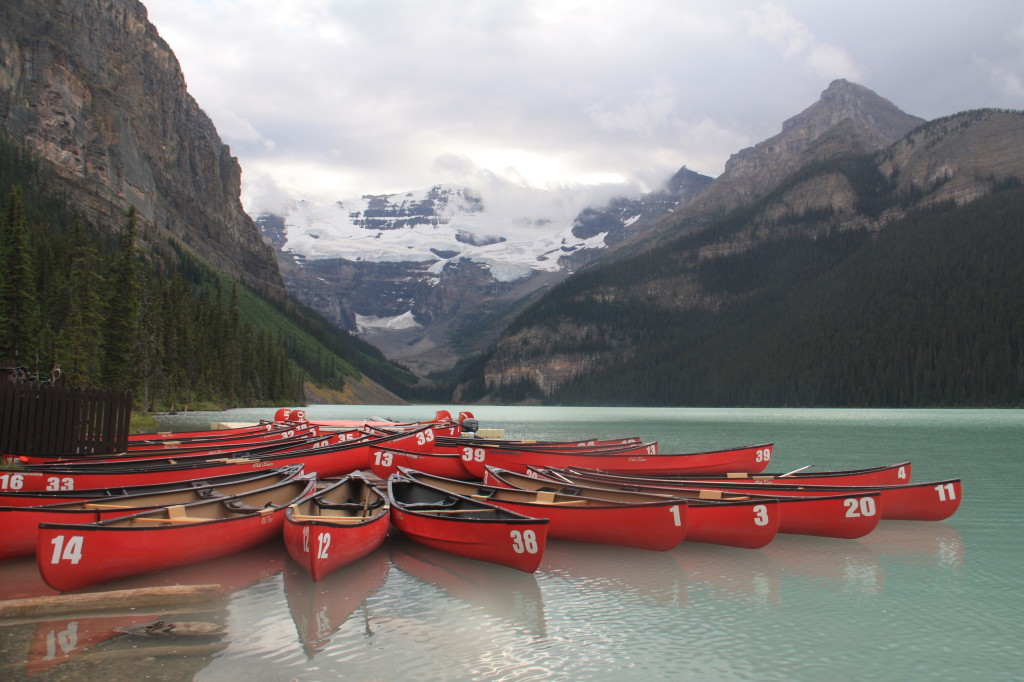
Part 3: The journey to others
“In helping others, we shall help ourselves, for whatever good we give out completes the circle and comes back to us.” ~ Flora Edwards
The final destination on this journey was a small prairie town, perched on the border between Saskatchewan and North Dakota, that looked a lot like the prairie town I grew up in. In North Portal, people trust each other enough to not only leave their doors unlocked but to leave the border unlocked. When you go golfing, you start out in one country and end in another, and they trust you to leave the parking lot through the same entrance (Canadian or American) that you entered through – no passport required. There used to be churches on either side of the border, but when their numbers dwindled, they joined and now meet in the new Canadian church in winter and in the older American church in summer.
In that town, there is an old school building that looks a lot like the place I spent the first nine years of my school life. There are not enough kids in town to fill it anymore, so they started bussing the kids to another town and sold the building to one of the townsfolk who put a friendly neighbourhood bar in one classroom and rents the other classrooms out to artists, healers, and others who need space.
In that building, Visions Art Guild holds their annual retreat. It’s a blissful week of summer camp for artists, with the local church ladies catering their meals, and everyone pitching in to do the dishes and keep the place clean. During the day, they make lots of art, have occasional inspirational sessions, and encourage each others’ creativity. In the evenings, they drink wine, make a little more art if they feel like it, and have a few good belly laughs (especially on the night of Frida Fest, when everyone dresses as their favourite Frida Kahlo painting or photo).
Every second year, they bring in a facilitator to inspire them in some area of growth. This year I was that lucky facilitator. On the theme of journey, I was invited to do three full sessions (a couple of hours each), three mini-sessions (about 45 minutes each), and one-on-one coaching sessions for anyone who wanted them (nine sessions). In between I got to make my own art and wander from station to station being inspired by the different styles and different mediums. Some worked in acrylics, watercolour, and oil, one added tiny twirly stitches to art prints, one did beautiful beadwork, one made fanciful beings out of found objects, one played with adding fabric prints of her prairie photos to her loomed rugs, one incorporated hand-dyed paper with natural objects, and one worked on a complex mixed media collage backdrop for her fanciful raven drawings. I dabbled with acrylics, watercolours, and mandalas, and took a lot of photos.
At the beginning of our week together, one of the retreatants helped me make a labyrinth in the grass, and that became the foundation of our exploration into the theme of journey. On the second day, I read Dr. Seuss’ “Oh the Places You’ll Go”, made road signs for the twelve places in the journey from the book (the prickly perch, the waiting place, etc.), and added those to the labyrinth. In addition, I’d collaged the words they’d sent me in response to some advance journal prompts onto a long piece of paper that represented the journey we were on for the week, and that piece of paper became a group art project that we added to throughout the week. We also made prayer flags to represent the things we most want to invite into our lives, our art, and our relationships.
What can I say about that week? For starters, it was SO MUCH FUN! Hanging out with artists and being inspired by their creative techniques and their capacity to see beauty made my own artist heart soar. For another thing, it was SO RELAXING! Yes, I was facilitating and coaching, but there was just so little pressure and the women in the group were delightful to work with and host in circle. They were receptive and responsive to my questions, they jumped into my activities with their whole hearts, and they embraced me as one of their own. And for another thing, it was very, very FULFILLING. In the coaching conversations, when I saw their faces soften with some new wisdom that was growing in them, and in the circle when I saw them opening themselves to new stories that will help them walk in the world with new courage, I knew that God was working through me to create safe space for their authenticity to show up.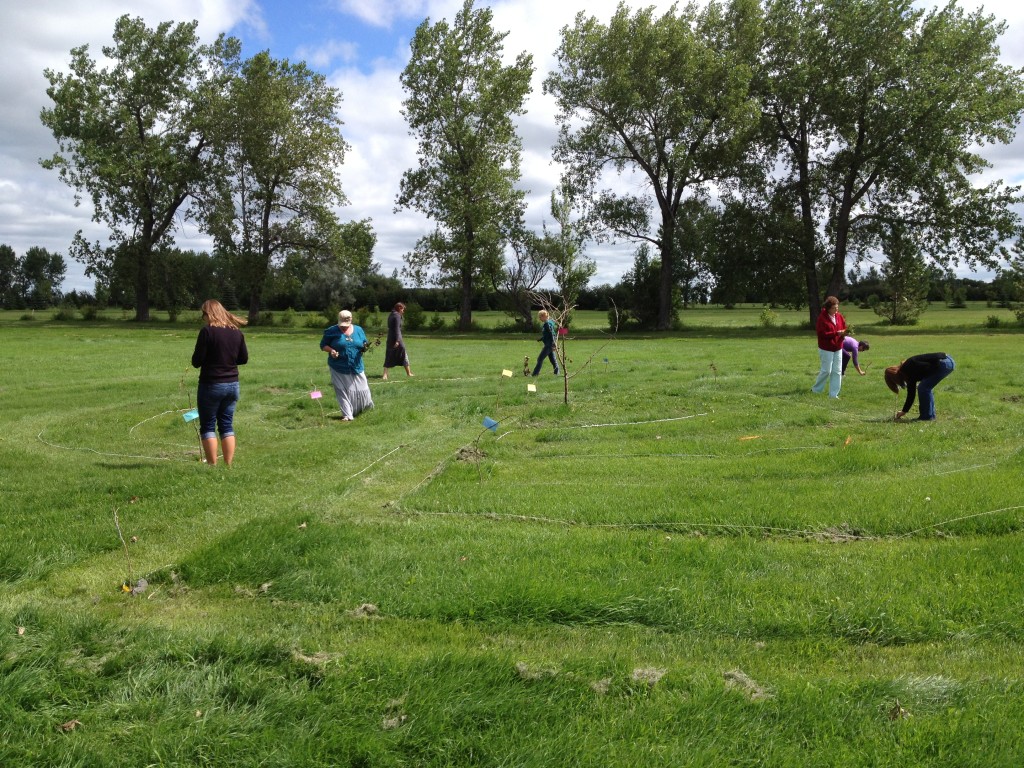
This is my absolute favourite kind of work – gathering women in circle and fostering their growth, creativity, and leadership. This is the kind of work that feels so much like play I almost feel guilty when they pay me at the end of the week.
I left that little prairie border town feeling like I was floating on a cloud. That beautiful circle of women gifted me with more than I could have possibly gifted them. They gave me tangible gifts (shoes, jewelry, a hand-woven rug, artist trading cards, and more), but the intangible gifts were far greater. They gave me love, acceptance, inspiration, and trust.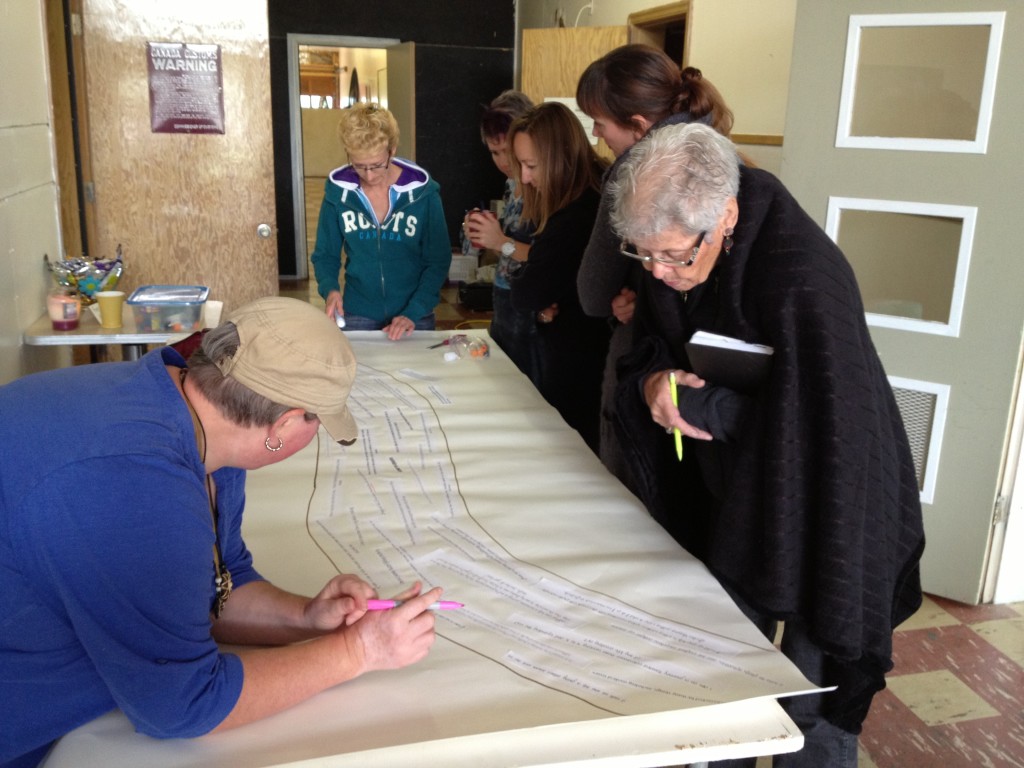
Part 4: The scary part of the journey that reminds me of the value of all the rest
“If you live to be a hundred, I want to live to be a hundred minus one day so I would never have to live without you.” ~Winnie the Pooh
This part of the journey was so brief it hardly bears mentioning, and yet it was so impactful it belongs on this page.
About an hour before I got home, driving along a single lane highway, a half-ton truck coming toward me swerved into my lane when it was only about 100 metres away and came at me full speed. I swerved onto the gravel shoulder on my right, and then the truck swerved there too, looking like the driver was determined to kill me. I swerved left (thankfully there was no other traffic), missed the speeding truck by mere inches, and then started spinning out of control, convinced I would end up rolling in the ditch. I finally came to a stop in the middle of the road, and turned back into my lane.
In the rearview mirror, I could see that the truck had turned around and was coming toward me again. I took off as quickly as I could, not interested in sticking around to see if they were coming to check if I was okay and apologize or try to kill me again.
The rest of the way home, my heart was racing, and I kept bursting into spontaneous tears. Just the day before, while still at the retreat, I’d gotten an email from Brad saying that the prognosis on his cancer is not good, that it has spread to his liver and possibly his lungs, and that – even with chemo and surgery – there is an 80% chance the cancer will kill him within 5 years. Between my near-death moment and the knowledge that I might soon lose my brother, life started feeling exceedingly fragile.
When I got home, hugs from my kids and a hot bath helped calm me down. I had to host a call for Lead with Your Wild Heart, so I did what I could to centre myself and be present for whoever showed up. Fortunately, the call morphed into a delightful hour-long conversation about the value of hosting meaningful conversations in circle, and I became energized talking about the work that most inspires me. That call also inspired me to write the following on Facebook:
Life is short. I know it sounds cliched, but believe me – it is. One day you find out there is an 80% chance your brother’s cancer may kill him in less than 5 years, and the next day a crazy driver tries to kill you, and then you find out a dear friend is having eye and kidney complications far away in South Africa and you can’t hug her, and everything just feels so fragile that you want to gather everyone around you and hug them and tell them to BE REAL, BE PRESENT, and BE GOOD TO EACH OTHER. There is just NO DAMN POINT in wasting your time doing things that are not authentic and full of love and true to the purpose God put you on this earth for.
Please… do me a favour, and stop wasting your time with lies and masks and artificial lives. Stop trying to please the people who don’t have your best interests at heart. Stop trying to live up to an unrealistic ideal that has nothing to do with who you are. Stop trying to find your happiness in money and possessions and fake happiness. Find people who believe in the beauty that is in you, hang onto them, and don’t stop holding each other until you all emerge with more courage to do the things the world is longing for you to do. And then hold onto each other some more, until you have spread every last bit of love God has put in you to spread and your work on this earth is done.
I nearly died on the highway today, and that moment shook me to the core, but at least I can say one thing… I would have spent my last week on earth doing EXACTLY the kind of work that I was put on this earth for – hosting REAL people in circle, giving them a safe space to be authentic, encouraging their creativity, and inviting them to live to their most beautiful potential.
I will keep doing this work and spreading this love until my time is done. Are you with me?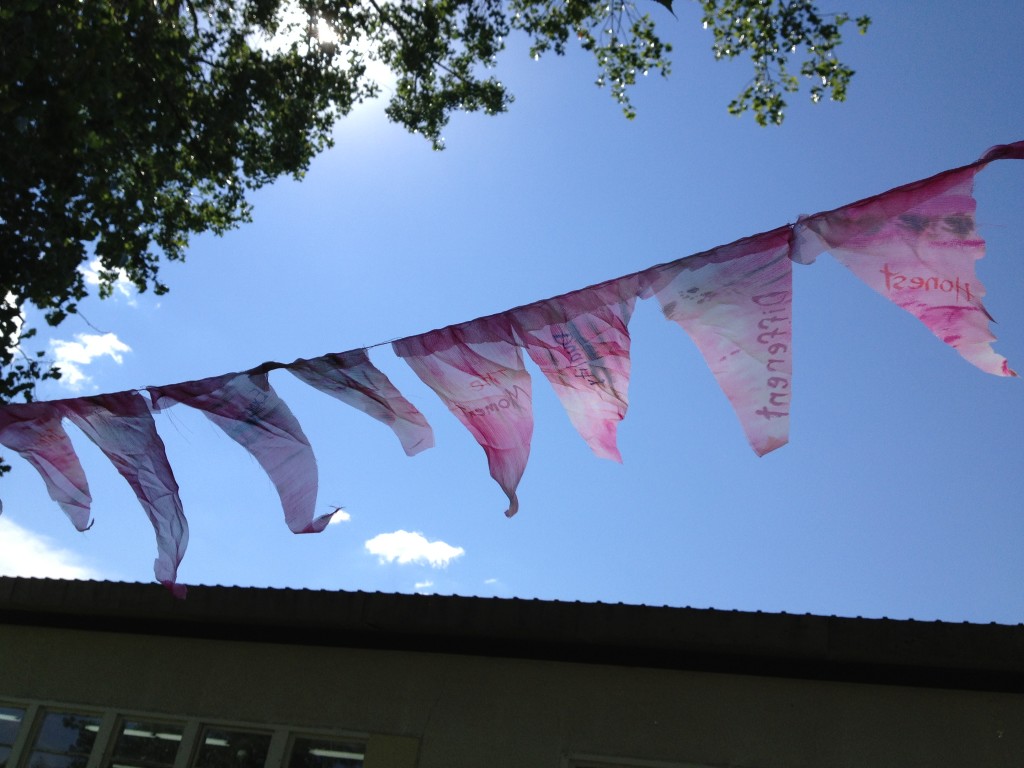
And with that, I end this part of my journey but continue on with the ongoing journey of my life, loving the people around me, living in the beauty that God is making of me, and serving the world with the gifts that have been entrusted to me with whatever time is left for me on this earth.
If you’re on a similar journey to a deeper place, and could use a guide to help you, consider signing up for one of my “Back to School” coaching sessions.
 Today after wandering as far as the path would take me, I found myself drawn into the shadows.
Today after wandering as far as the path would take me, I found myself drawn into the shadows.
 Then it was the lichen on a decaying branch. Like a tiny white forest perched precariously on a cliff.
Then it was the lichen on a decaying branch. Like a tiny white forest perched precariously on a cliff. The closer I looked, the more I marveled at the intricate beauty growing in the shadows.
The closer I looked, the more I marveled at the intricate beauty growing in the shadows. Crouching down in the moss, a whole world unfolded under my gaze.
Crouching down in the moss, a whole world unfolded under my gaze. There were mosses in a thousand shades of green.
There were mosses in a thousand shades of green. My knees were soon green and moist with reverence.
My knees were soon green and moist with reverence. And as I marveled, I knew that I had opened an doorway into a universal truth.
And as I marveled, I knew that I had opened an doorway into a universal truth. Once again, the woods were teaching me, tapping me on the shoulder and saying “Pay attention. This is important.
Once again, the woods were teaching me, tapping me on the shoulder and saying “Pay attention. This is important. In the darkest of days, the unexpected shows up and offers grace.
In the darkest of days, the unexpected shows up and offers grace.



 When the weeping subsided, I opened my journal and began to draw the river of blood. As I sketched, the words came to me… “The river of blood will heal this land.”
When the weeping subsided, I opened my journal and began to draw the river of blood. As I sketched, the words came to me… “The river of blood will heal this land.”















